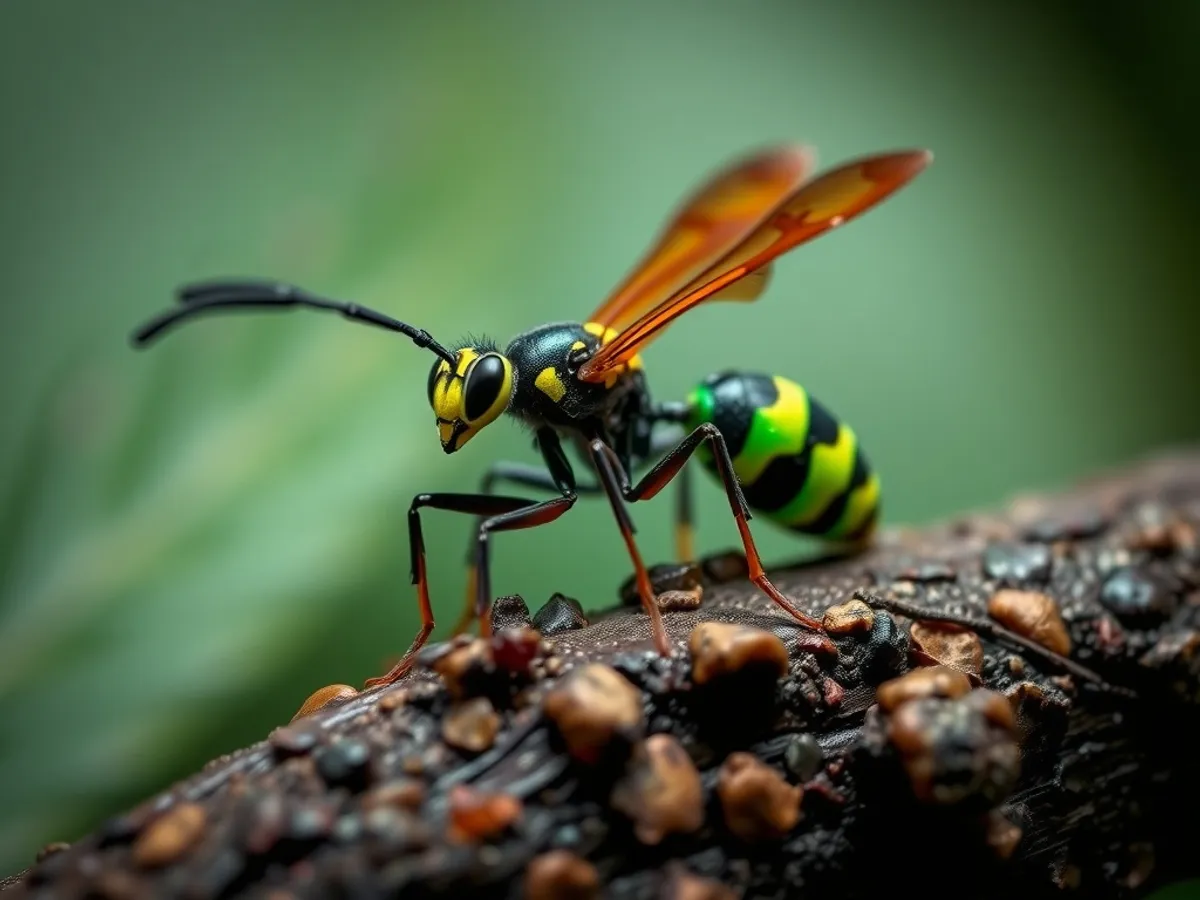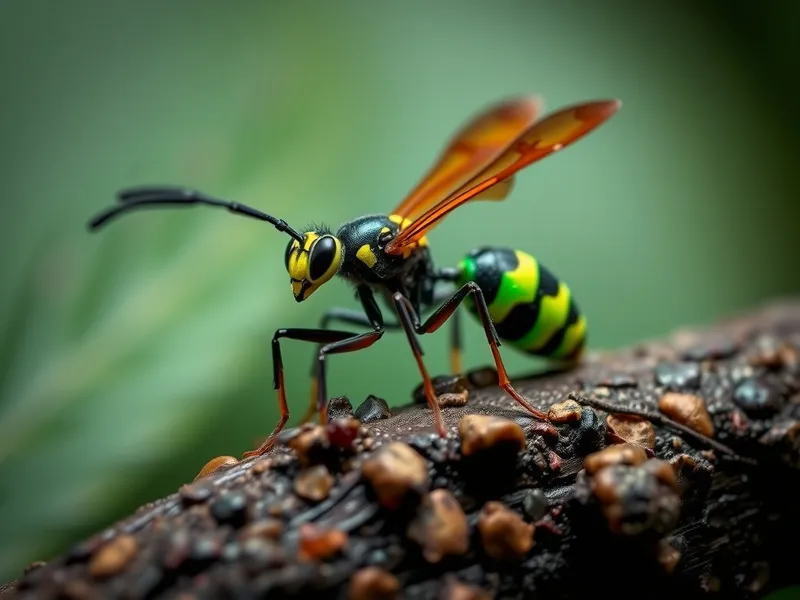
Jewel Wasp
Ampulex compressa

Meet the Jewel Wasp
The Jewel Wasp, also known as the Emerald Cockroach Wasp, is a striking parasitoid wasp known for its metallic blue-green sheen. Native to tropical regions of South Asia, Africa, and the Pacific Islands, this wasp is famous for its unique reproductive strategy, which involves controlling the behavior of cockroaches. The female Jewel Wasp injects venom into the cockroach's brain, effectively zombifying it, and leads it to a burrow where it lays an egg on the immobilized host. The developing larva feeds on the cockroach, eventually pupating and emerging as an adult wasp.
Classification
Invertebrate
Habitat
Tropical forests and woodlands
Diet
Carnivore
Lifespan
3-6 months
Conservation
Least Concern
Weight
0.05-0.1 grams
📖Fascinating Facts
Masters of Mind Control
The Jewel Wasp injects venom into two specific regions of a cockroach’s brain, first paralyzing its front legs, then suppressing its escape reflex, essentially turning it into a living food supply for its larva.
Iridescent Armor
Their metallic blue-green exoskeleton reflects light in a dazzling display, which helps deter predators and gives them their 'jewel' name.
Unusual Parenting
Rather than caring for their young directly, female Jewel Wasps provide their larvae with a live, immobilized cockroach to feed on until development is complete.
📋Detailed Description
The Jewel Wasp (Ampulex compressa) is a solitary parasitoid wasp notable for its iridescent metallic green and blue exoskeleton, measuring approximately 22–28 mm in length. Its slender body is equipped with long, spiny legs and a narrow waist, typical of the family Ampulicidae. The wasp's head features large, well-developed compound eyes and elongated antennae, which are crucial for detecting chemical cues from potential hosts. Jewel Wasps are best known for their intricate parasitic relationship with cockroaches, particularly the American cockroach (Periplaneta americana). Females exhibit highly specialized venom-injecting behavior, using their stinger to deliver a two-stage neurotoxic cocktail that selectively disables the cockroach's escape reflexes without killing it. The wasp then leads the subdued cockroach by its antennae to a pre-dug burrow, where it lays a single egg on the host's leg. After hatching, the larva feeds externally before burrowing into the cockroach to consume vital organs in a precise sequence, ensuring the host remains alive until pupation. Adults are diurnal and exhibit strong flying abilities, often found in shaded, humid microhabitats. While largely solitary, they may aggregate in areas with abundant host availability. Their lifecycle is closely synchronized with host abundance and environmental conditions, making them key regulators of cockroach populations in their native ecosystems.
💡 Did you know?
Jewel Wasps perform precise neurosurgery with their stinger, targeting specific parts of a cockroach's brain to alter its behavior.
🔬Research & Sources
🎭Behavior & Social Structure
Jewel Wasps are solitary hunters with highly specialized predatory behavior. Females actively seek out cockroach hosts using olfactory and tactile cues, often patrolling leaf litter or decaying wood. Upon encountering a cockroach, the wasp delivers two precise stings: the first into the thoracic ganglia to temporarily paralyze the legs, and the second into the subesophageal ganglion of the brain, which suppresses the cockroach's escape response. The wasp then chews off half of each antenna, reducing the host's sensory input, and guides it to a burrow by pulling on the remaining antennae. Feeding behavior in adults is primarily nectarivorous, supplementing their diet with honeydew and occasionally hemolymph from prey. Males are less frequently observed and do not participate in host hunting. Daily activity peaks during the early morning and late afternoon, coinciding with higher humidity and cockroach activity. Social interactions are minimal outside of mating, and territoriality is not pronounced.
👶Reproduction & Life Cycle
Mating in Ampulex compressa typically occurs shortly after adult emergence, with males releasing pheromones to attract females. Courtship involves antennal tapping and wing vibration displays. Females are capable of producing multiple clutches during their lifespan, each requiring a live cockroach host. After oviposition, the female seals the burrow entrance with debris to protect the developing larva. The egg hatches within 2–3 days, and the larva undergoes three instars over 5–8 days, feeding externally before entering the host for endoparasitic development. Pupation occurs within the cockroach's body, lasting 3–4 weeks, after which the adult wasp emerges. There is no parental care beyond host provisioning, and breeding can occur year-round in tropical climates, with population peaks following seasonal increases in host abundance.
🛡️Adaptations & Survival
The Jewel Wasp exhibits several remarkable adaptations, including a highly specialized stinger capable of delivering neurotoxins with surgical precision. Its venom contains a unique blend of GABA, taurine, and beta-alanine, which selectively targets neural circuits controlling locomotion in cockroaches. The wasp's iridescent exoskeleton provides camouflage among foliage and may deter predators through aposematic signaling. Chemosensory adaptations in the antennae enable efficient host detection, while mandibular modifications facilitate antennae mutilation and burrow excavation. The larval feeding strategy is evolutionarily optimized to preserve the host's viability until pupation, minimizing competition and maximizing survival rates.
📚Research Sources
🎨Cultural Significance
The Jewel Wasp has fascinated scientists and the public alike due to its 'zombification' of cockroaches, often cited in discussions of behavioral manipulation in nature. It has appeared in documentaries, popular science literature, and educational materials as an example of evolutionary adaptation and parasitoid-host dynamics. In some cultures, its striking appearance has inspired local names and folklore, though it is not known to have significant roles in traditional medicine or symbolism.
🔬Recent Research & Discoveries
Recent research has focused on the neurobiology of the Jewel Wasp's venom, revealing its ability to modulate specific neurotransmitter pathways in cockroach brains. Studies published in journals such as 'Science' and 'Proceedings of the National Academy of Sciences' have elucidated the molecular composition of the venom and its effects on host behavior. Ongoing research explores the potential biomedical applications of wasp venom peptides in neuromodulation and pain management. Behavioral ecologists are also investigating the evolutionary arms race between wasps and cockroaches, including host resistance mechanisms and wasp counter-adaptations.
🎥Wildlife Videos

Beautiful wasp zombifies cockroach
If you like what we do please consider supporting us on Patreon. https://www.patreon.com/teamcandiru We want to take a second ...
Team Candiru

(ENG SUB) A Jewel-Like "Wasp" that Only Hunts Cockroaches
The ""emerald cockroach wasp"" with a mystical jewel color is a wasp that hunts cockroaches. It is found in the temperate climates ...
EBS WORLD

Hunting the Heath Potter Wasp
John Walters is a professional entomologist and wildlife artist, who is a leading expert on our native insects, regularly consulted by ...
Phil Chandler: Barefoot Beekeeper

Parasitic Wasp vs. Worm: Nature’s Most Intriguing Survival Strategy!
Nature's complexity never ceases to amaze! This fascinating footage captures the extraordinary survival strategy of parasitic ...
AQUAVISION

Parasitic Wasps Inside Parasitic Wasps
Here's a link to Nancy's YouTube: https://www.youtube.com/c/NancyMiorelliSciBugs Here's the link to my website where you'll be ...
Stated Casually

God Level Hunters. 10 Insects-Predators With Ingenious Hunting Skills
For copyright matters please contact us at: copymanagerwatop@gmail.com.
WATOP
🌍Habitat Information
The Jewel Wasp typically inhabits Tropical forests and woodlands environments. Jewel Wasps have adapted to their environments with specialized features and behaviors.
Primary Habitat:
Tropical forests and woodlands
More detailed habitat information will be available soon.
🛡️Conservation Status
The Jewel Wasp is currently classified as Least Concern. Conservation efforts are crucial for preserving this species for future generations.
Common Threats:
- 🏠Habitat loss and fragmentation
- 🌡️Climate change impacts
- 🎯Hunting and poaching
- 🏭Human-wildlife conflict
⚠️Threats & Conservation Challenges
Currently, Ampulex compressa faces few significant threats due to its wide distribution and adaptability to disturbed habitats. However, habitat loss from deforestation and urbanization may locally impact populations by reducing host availability. Pesticide use targeting cockroaches can indirectly affect wasp populations. Climate change poses potential long-term risks by altering the distribution of both wasps and their hosts. Despite these challenges, the species is classified as Least Concern, with stable population trends across its range.
🔬Scientific Classification
Scientific Name
Ampulex compressa
Classification Hierarchy
🔍 About Taxonomic Classification
Taxonomic classification is a hierarchical system used by scientists to classify and organize living organisms based on shared characteristics and evolutionary relationships.
The system moves from broad categories (Kingdom) to increasingly specific ones, with each animal's scientific name typically consisting of its Genus and species.
📝Community Notes
Share your observations and insights about the Jewel Wasp with our community of wildlife enthusiasts.
Join Our Community
Sign in to share your observations and connect with fellow wildlife enthusiasts.
Sign In to ContributeNo community notes yet
Be the first to share your observations about the Jewel Wasp!
Explore Jewel Wasp
Select a tab above to learn more about this amazing animal.
📸Photo Gallery
No photos available for this animal yet.
🌟Discover More Wildlife
Continue your journey of discovery with more fascinating animals from our database
